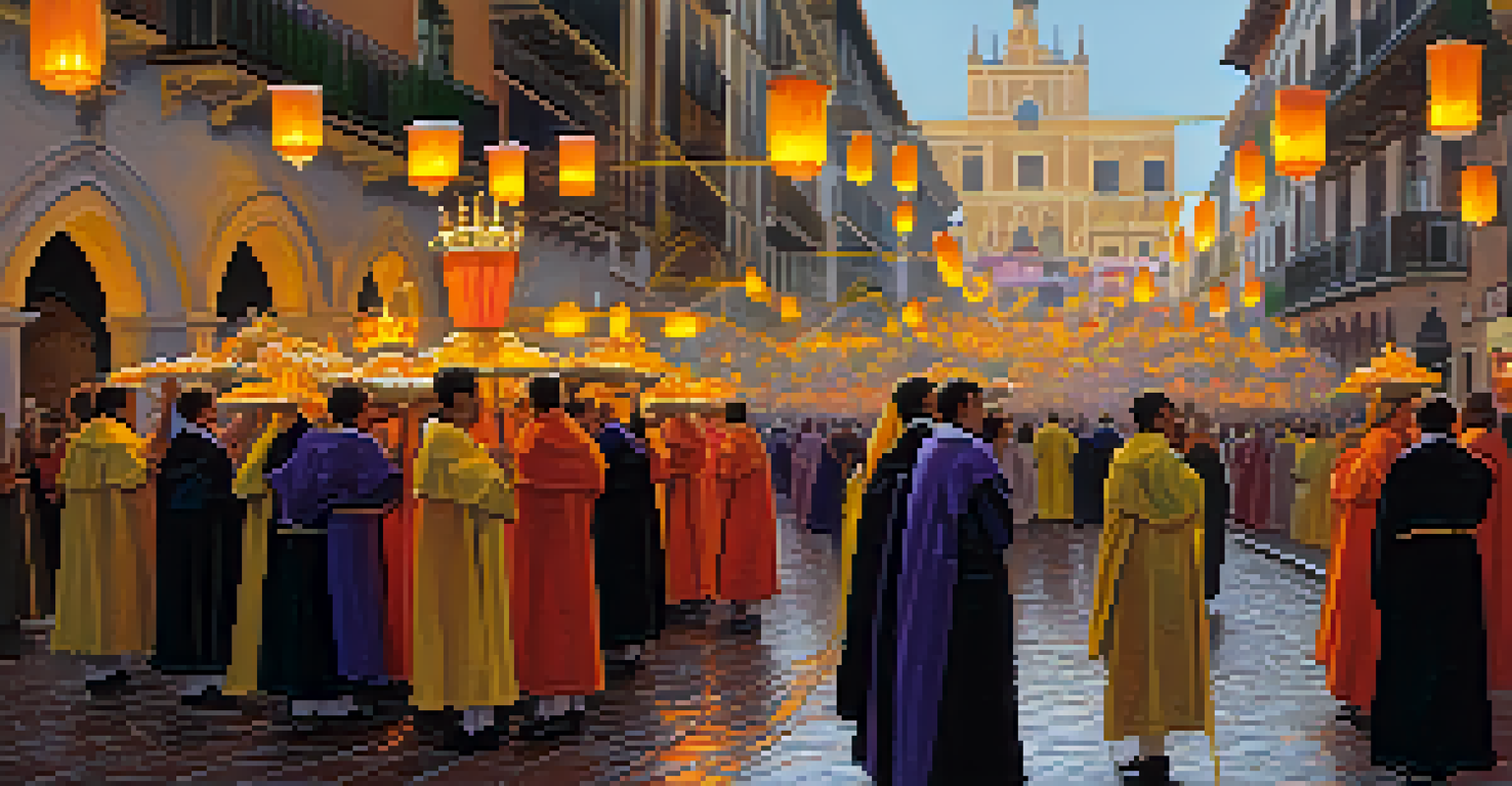Understanding the History of Spain's Sacred Sites

The Origins of Spain's Sacred Sites
Spain's sacred sites date back thousands of years, showcasing a blend of various cultures. From prehistoric caves adorned with ancient art to the grand temples of Roman influence, these locations reveal the spiritual journey of the Iberian Peninsula. Each site tells a story, reflecting the beliefs and traditions of the people who worshipped there.
The earth has music for those who listen.
The earliest sacred sites in Spain, like the Altamira Cave, highlight the connection between ancient humans and their spiritual world. These caves, adorned with stunning paintings, served as places of reverence and ritual. Over time, as civilizations evolved, so did the nature of these sacred spaces, adapting to new religious practices and influences.
The arrival of Christianity marked a significant transformation in Spain’s sacred landscape. As churches and cathedrals began to dot the countryside, they often replaced older pagan sites, blending the old with the new. This layering of beliefs is part of what makes Spain's sacred sites so intriguing.
The Influence of the Moors on Sacred Architecture
The Moorish conquest of Spain in the 8th century brought a remarkable architectural style that left a lasting mark on sacred sites. Mosques like the Great Mosque of Córdoba showcase intricate designs and beautiful arches, reflecting a deep appreciation for artistry in worship. This blend of Islamic and Christian elements is a testament to Spain's complex religious history.

Many churches were built on the foundations of former mosques, symbolizing the cultural and religious shifts in the region. The transition from Islamic to Christian worship often involved maintaining the stunning architectural features while adding new elements, creating a unique fusion. This is evident in sites such as the Mezquita-Catedral, a breathtaking example of this architectural dialogue.
Spain's Sacred Sites: A Historical Tapestry
Spain's sacred sites reflect a rich blend of cultures and traditions, evolving from prehistoric caves to grand cathedrals.
The Moorish influence is not just limited to buildings; it also permeates the landscapes surrounding these sacred sites. Gardens, fountains, and courtyards designed for reflection and tranquility were common features. These elements continue to create a serene atmosphere for visitors today.
The Significance of Santiago de Compostela
Santiago de Compostela is one of the most important pilgrimage sites in Spain, drawing thousands of visitors each year. The city is renowned for its cathedral, which is said to house the remains of Saint James, one of Jesus' apostles. This makes it a pivotal destination for those on the Camino de Santiago, a historic pilgrimage route that stretches across Europe.
A journey of a thousand miles must begin with a single step.
The journey to Santiago de Compostela has been a spiritual quest for centuries, symbolizing a path of personal reflection and growth. Pilgrims often embark on this trek for various reasons, from seeking spiritual enlightenment to simply enjoying the stunning landscapes. The camaraderie among travelers adds to the site's unique atmosphere.
Over the years, Santiago has evolved into a vibrant hub of culture and spirituality, with numerous festivals and events celebrating its rich history. The fusion of ancient traditions with modern practices creates a dynamic experience for visitors. This blend makes the city a living testament to Spain's sacred heritage.
The Role of Cathedrals in Spanish Society
Cathedrals in Spain are not just places of worship; they serve as community centers and symbols of cultural pride. From the majestic Sagrada Familia in Barcelona to the Gothic Cathedral of Toledo, these structures reflect the artistry and architectural advancements of their time. They stand as reminders of the deep-rooted faith that shaped Spanish society.
These sacred spaces often host significant events, from religious ceremonies to cultural festivals, reinforcing their role in the community. The grandeur of cathedrals attracts both locals and tourists, making them central to the social fabric of Spanish life. They also house invaluable art and artifacts, further enhancing their importance.
Moorish Influence in Sacred Architecture
The architectural legacy of the Moors is evident in Spain's sacred spaces, merging Islamic and Christian elements in stunning designs.
Moreover, the construction of cathedrals often spanned generations, showcasing the dedication of the communities that built them. Each stone laid tells a story of faith, resilience, and artistry, creating a lasting legacy. This connection to history enriches the experience for anyone who visits these sacred sites.
The Legacy of Religious Festivals in Spain
Religious festivals in Spain are vibrant celebrations that bring communities together, often tied to sacred sites. Events like Semana Santa (Holy Week) and La Tomatina reflect the deep-rooted traditions that honor both faith and culture. These festivals attract visitors from all over the world, showcasing the colorful tapestry of Spanish life.
During Semana Santa, elaborate processions take place in cities like Seville, where people gather to witness the stunning floats and hear the haunting music. This event transforms streets into a living gallery of devotion and artistry, highlighting the importance of sacred traditions in Spanish society. It's a powerful reminder of the spiritual connections people maintain with their heritage.
Similarly, La Tomatina, though not strictly religious, reflects the communal spirit that many festivals embody. It’s a fun-filled event that, while playful, is rooted in local history and traditions. Festivals like these show how sacred sites can serve as focal points for joyous celebration, bridging the gap between the sacred and the secular.
Exploring the Natural Sacred Spaces of Spain
Spain is home to numerous natural sacred spaces that hold spiritual significance, such as the Sierra de Guadarrama and Montserrat. These locations offer breathtaking landscapes that invite contemplation and connection with nature. Mountains and valleys often serve as backdrops for ancient rituals and modern spiritual practices alike.
Many of these natural sites are intertwined with local legends and folklore, adding layers of meaning to their beauty. For example, Montserrat is known for its stunning rock formations and the famous Black Madonna, drawing pilgrims and visitors seeking solace and inspiration. The connection to nature at these sites fosters a sense of peace and reflection.
Preserving Sacred Heritage for Future
Efforts to preserve Spain's sacred sites involve restoration, education, and community engagement to maintain their historical significance.
Visiting these natural sacred spaces allows individuals to step away from the hustle and bustle of daily life. They offer a chance to reconnect with oneself and the environment, echoing the spiritual journeys of those who came before. These experiences highlight the diverse ways in which sacredness can be found beyond man-made structures.
Preserving Spain's Sacred Heritage for Future Generations
As Spain's sacred sites continue to attract visitors, the importance of preserving these treasures becomes increasingly clear. Efforts are being made to protect the historical integrity and cultural significance of these locations. This includes restoration projects, educational initiatives, and sustainable tourism practices.
Museums and cultural organizations play a vital role in educating the public about the history and importance of these sacred sites. By sharing stories and artifacts, they foster a deeper appreciation for Spain's diverse religious heritage. This educational aspect helps ensure that future generations can experience and understand the significance of these places.

Moreover, local communities are often at the forefront of preservation efforts, recognizing the value of their traditions and history. Engaging locals in these efforts not only helps maintain the sites but also strengthens community bonds. Together, they work to keep the essence of these sacred spaces alive, passing on their rich history to those who will come after.